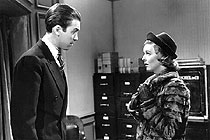|
|
|
|
The
Shop Around the Corner
|
 |
|
A group of workers gather each day at a store that sells trinkets such as wallets and cigarette boxes. They exchange words over counters, in the back storeroom, at the door of their boss's office. Time passes, Christmas comes, life stories quietly unfold as characters pursue romance or face a crisis – but still we remain mostly within the shop, or very near it. Would it be possible for a filmmaker to pitch this story to a major studio today without immediately receiving the response that it is far too stagey? Yet, in 1940, one of Old Hollywood's greatest popular artists, Ernst Lubitsch, made The Shop Around the Corner to these precise specifications – and it is a completely filmic, quietly virtuosic masterpiece of screen comedy. The moment-to-moment inventiveness of this film – its wit, economy, rhythm, interplay of light and dark moods – is astounding. Rarely have a director and writer (Samson Raphaelson) collaborated with such a subtle and intricate understanding of each other's craft. Every major plot move, each tiny detail that advances the intrigue or deepens our apprehension of the characters is also a building-block in Lubitsch's patient sculpting of the times, spaces, moods and possibilities of his central location: the shop. On a broader level, the film tells a classic romantic comedy story, one that has often been re-jigged in the history of the genre (most recently in the dire You've Got Mail [1998]). Kralik (James Stewart) writes letters to an amorous pen pal, completely unaware that she is really Clara (Margaret Sullavan), his workmate. On the shop floor, their relationship is antagonistic, feisty – and Lubitsch spares us none of the pain or humiliation that spring from the plot's central irony. Around Kralik and Clara flit other characters, other tales – particularly the unhappy marriage of the boss, Matuschek (Frank Morgan), and his suspicion that Kralik is having an affair with his wife. Mrs Matuschek – like so much that is referred to in the film – is kept invisible, just out of the frame or far beyond its limit. This is another hallmark of Lubitsch's art: his systematic use of indirection, suggestion, allusion and metaphor (crudely known as the Lubitsch Touch). Raphaelson's dialogue is just as complicated in its manoeuvres, and just as immediate in its emotional impact, as Lubitsch's direction. The film has very little explicitly comic dialogue; instead, everyone always speaks in some kind of code, camouflaging their true feelings and intentions. Like all good romantic comedies, this one moves towards a crowning moment of truth, revelation, authenticity. But where, in a modern film, such a finale might involve a passionate embrace or a spirited declaration, Lubitsch needs no strong words – only the unforgettable sight of Stewart, in the darkened shop, raising his trousers to show that he is not bow-legged. MORE Lubitsch: Trouble in Paradise, Angel, The Man I Killed, To Be or Not to Be MORE Lubitsch (book review): How Did Lubitsch Do It? by Joseph McBride © Adrian Martin January 1998 |
![]()